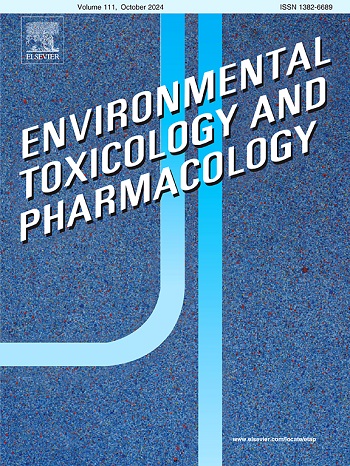人类颗粒细胞中的多环芳烃:首次在体内存在,并与体重指数和体外卵巢细胞类固醇生成调节呈正相关。
IF 4.2
3区 环境科学与生态学
Q2 ENVIRONMENTAL SCIENCES
引用次数: 0
摘要
多环芳烃(PAHs)暴露导致女性不孕症患者的疾病报道。我们的假设是多环芳烃根据身体质量指数(BMI)在颗粒细胞(Gc)中积累,并直接影响其功能。16种高优先级多环芳烃均存在于FF、Gc和血浆中,其中Gc (Gc -MS/MS)浓度最高。除苊和苊外,它们的浓度在肥胖Gc中最高,且与BMI呈正相关。在FF中,我们只发现萘与BMI呈正相关,而在血浆中,萘、苊、芘与BMI呈正相关。菲和萘抑制完全甾体生成(ELISA), CYP19A1 mRNA表达(real-time PCR),增加Gc氧化应激指数和过氧化氢酶表达,而非荧光蒽。而所有研究都表明,PAHs降低了Gc增殖(BrdU测定)和细胞活力(Cell Count kit-8测定)。因此,Gc多环芳烃浓度与BMI呈正相关,并改变卵巢功能。本文章由计算机程序翻译,如有差异,请以英文原文为准。
Polycyclic aromatic hydrocarbons in human granulosa cells: first in vivo presence and positive correlation with body mass index and in vitro ovarian cell steroidogenesis regulation
Polycyclic Aromatic Hydrocarbons (PAHs) exposure leads to disorders reported in female infertility patients. Our hypothesis is that PAHs accumulate in granulosa cells (Gc) according to body mass index (BMI) and directly affects its functions. All 16 high-priority PAHs were in human FF, Gc and blood plasma with the highest concentration in Gc (GC–MS/MS). Their highest concentration was in obese Gc, except for acenaphthene and acenaphthylene, and positively correlated with BMI. In FF, we noted only positive correlation between naphthalene and BMI, whereas in blood plasma positive correlation between naphthalene, acenaphthene, pyrene and BMI. Phenanthrene and naphthalene but not fluoranthene inhibited totally steroidogenesis (ELISA), CYP19A1 mRNA expression (real-time PCR) and increased oxidative stress index and catalase expression in Gc independently on BMI. While all studied PAHs decreased Gc proliferation (BrdU assay) and viability (Cell Count kit-8 assay). Thus, Gc PAHs concentrations are positively correlated with BMI and alter ovarian functions.
求助全文
通过发布文献求助,成功后即可免费获取论文全文。
去求助
来源期刊
CiteScore
7.00
自引率
4.70%
发文量
185
审稿时长
34 days
期刊介绍:
Environmental Toxicology and Pharmacology publishes the results of studies concerning toxic and pharmacological effects of (human and veterinary) drugs and of environmental contaminants in animals and man.
Areas of special interest are: molecular mechanisms of toxicity, biotransformation and toxicokinetics (including toxicokinetic modelling), molecular, biochemical and physiological mechanisms explaining differences in sensitivity between species and individuals, the characterisation of pathophysiological models and mechanisms involved in the development of effects and the identification of biological markers that can be used to study exposure and effects in man and animals.
In addition to full length papers, short communications, full-length reviews and mini-reviews, Environmental Toxicology and Pharmacology will publish in depth assessments of special problem areas. The latter publications may exceed the length of a full length paper three to fourfold. A basic requirement is that the assessments are made under the auspices of international groups of leading experts in the fields concerned. The information examined may either consist of data that were already published, or of new data that were obtained within the framework of collaborative research programmes. Provision is also made for the acceptance of minireviews on (classes of) compounds, toxicities or mechanisms, debating recent advances in rapidly developing fields that fall within the scope of the journal.

 求助内容:
求助内容: 应助结果提醒方式:
应助结果提醒方式:


